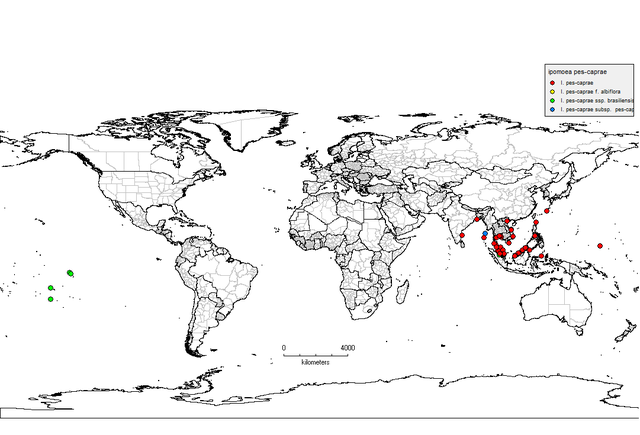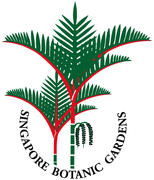Nomenclature
Ipomoea pes-caprae (L.) R. Br. in Tuckey, Narr. Exp. Zaire 477. 1818.
Convolvulus pes-caprae L., Sp. Pl. 1: 159. 1753
C. bilobatus Roxb.
C. brasiliensis L.
C. maritimus Desr.
Ipomoea biloba Forsskål
I. brasiliensis (L.) G. Meyer
I. brasiliensis (L.) Sweet
I. maritima (Desr.) R. Br.
I. pes-caprae (L.) R. Br. var. emarginata Hallier f.
I. pes-caprae subsp. brasiliensis (L.) Ooststr.
Ipomoea pes-caprae (L.) Sweet, Hort. Suburb. Lond. 35. (July) 1818, superfluous combination.
Convolvulus pes-caprae L., Sp. Pl. 1: 159. 1753.
Description
Fang R.C., G. Staples, et al. 1995. Convolvulaceae in P. Raven & C.Y. Wu (eds.) Flora of China 16: 271–325.
Cytology
Fang R.C., G. Staples, et al. 1995. Convolvulaceae in P. Raven & C.Y. Wu (eds.) Flora of China 16: 271–325.
Biogeography, Ecology and Natural History

A pantropical littoral species: China (Fujian, Hainan, Taiwan, Zhejiang), Cambodia, Indonesia, Japan including Ryukyu Islands, Malaysia, Myanmar (Great Cocos Is.), New Guinea, Pakistan, Philippines, Sri Lanka, Thailand, Vietnam; Africa, SW Asia, Australia, North America, Pacific Islands, South America.
Sandy
seashores, open fields near seashores; near sea level to 100 m.
Flowering: March–June, August, October, November; fruiting: February, October.
Fang R.C., G. Staples, et al. 1995. Convolvulaceae in P. Raven & C.Y. Wu (eds.) Flora of China 16: 271–325.
Staples, G. 2010. Convolvulaceae. Fl. Thailand 10(3): 330–468.
Other information
Although Van Ooststroom (Blumea 3: 532–539. 1940) recognized two subspecies based on the depth of apical lobing of the leaf blades, we do not accept any infraspecific taxa. In our experience a change in growing conditions can produce variation in leaf lobing on the same plant.
Ooststroom (Fl. Males. ser. I, 4: 475. 1953) and many other authors have recognized two subspecies (ssp. pes-caprae and ssp. brasiliensis (L.) Ooststr.) based on the depth of lobing at the leaf apex. This character varies on the same plant and is not worthy of taxonomic recognition, so no infraspecific taxa are recognized here.
Authorship for webpage


Add new comment